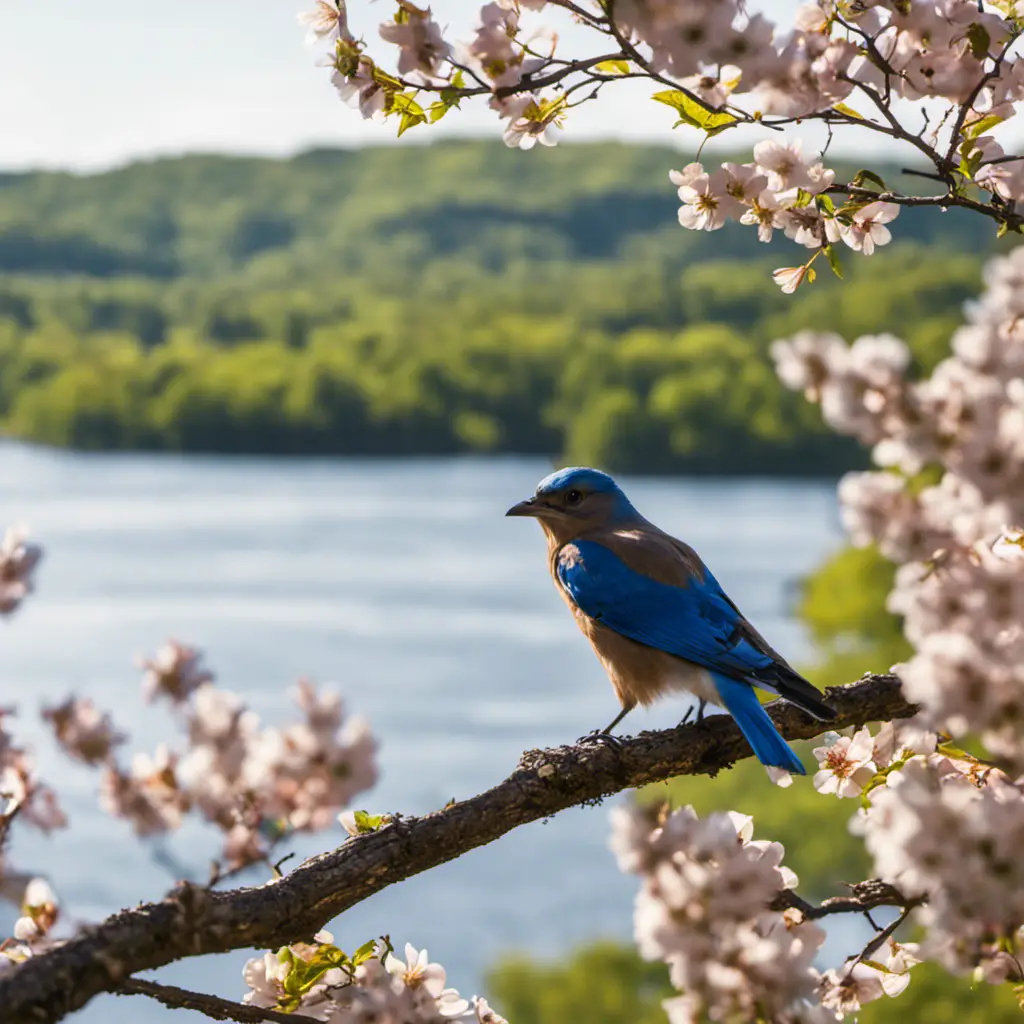Idaho is home to many bird species, both year-round residents and migratory visitors. Some of the most commonly seen birds in Idaho include the American robin, bald eagle, black-capped chickadee, northern flicker, and barn swallow.
Different birds live in different parts of the world, and today we’ll introduce you to some of the most common backyard birds that can be found in Idaho. Along with pictures, we’ll provide key data about each one. All our information comes from reliable sources that have been verified by an expert Ornithologist.
Common Backyard Idaho Birds
American Robin
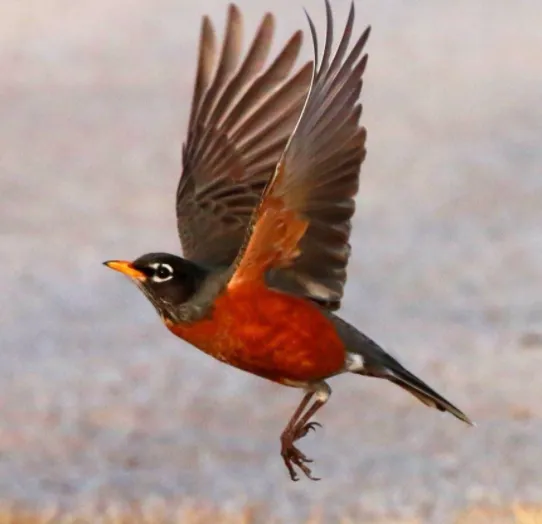
(Turdus migratorius) can be identified by its dark gray-brown upper body and reddish-orange breast. Its diet consists mainly of worms, insects, fruits, and berries.
The average size ranges from 9 to 11 inches in length with a wingspan of 14 inches. In Idaho, American Robins can be found in open areas with access to trees for nesting and foraging, such as parks, residential areas, and agricultural fields.
They are also known for their territorial behavior during breeding season when the male will sing from prominent perches to defend his territory. Outside of the breeding season, these backyard birds can be seen in large flocks foraging together on the ground.
Additionally, American Robins are common migrant birds in Idaho, typically arriving in early spring and leaving for their wintering grounds in late fall. They have also been known to adjust their migration patterns based on food availability. Overall, the American Robin is a common and familiar sight across much of North America.

House Finches
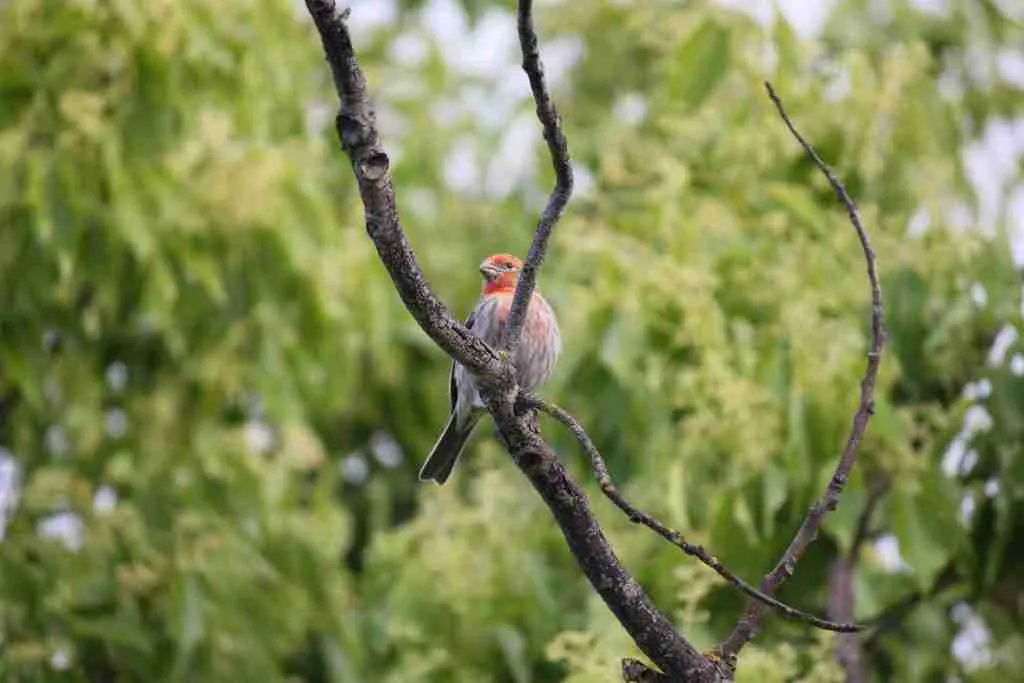
(Carpodacus mexicanus) can be identified by their reddish-brown feathers and a small conical bill. They have a diet consisting mainly of grains and seeds, but also insects and fruit.
They average about 5-6 inches in length with a wingspan of about 8 inches. These birds can be found in open habitats, including suburban areas, farms, and parks.
They typically form monogamous pairs and build cup-shaped nests in trees or shrubs. These backyard birds are often seen in small flocks, foraging on the ground or perching on feeders. Their songs consist of repetitive chirps and trills.

Mourning Doves
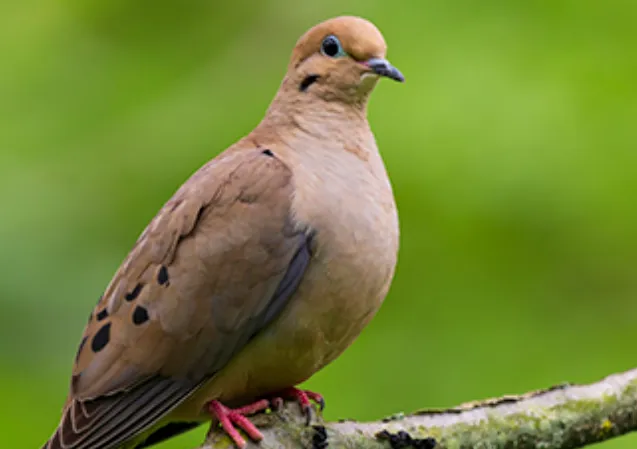
Mourning Doves are easily identified by their long, pointed tails and soft gray and brown coloring. They have a black spot on their neck and a distinctive call that sounds like “mourn-AH-ing.” In Idaho, these backyard birds can often be found near open fields and agricultural areas where they feed on black oil sunflower seeds from plants and crops.
Mourning Doves typically have a smaller body size, with an average length of 11-12 inches and weight of about 4 ounces.
They typically live in open woodland areas, fields, and near human settlements.
Mourning Doves are known for their peaceful behavior and often gather in large flocks outside of breeding season. During breeding season, pairs may establish a territory and build a flimsy nest in trees or shrubs. The female typically lays 2 eggs, and both parents take turns incubating them until they hatch after about two weeks.
Mourning Doves are common throughout North America and their population is stable. However, they are often hunted for sport as well as for food. Hunting regulations and limits vary by state, so it is important to check local laws before hunting these birds.

American Goldfinch
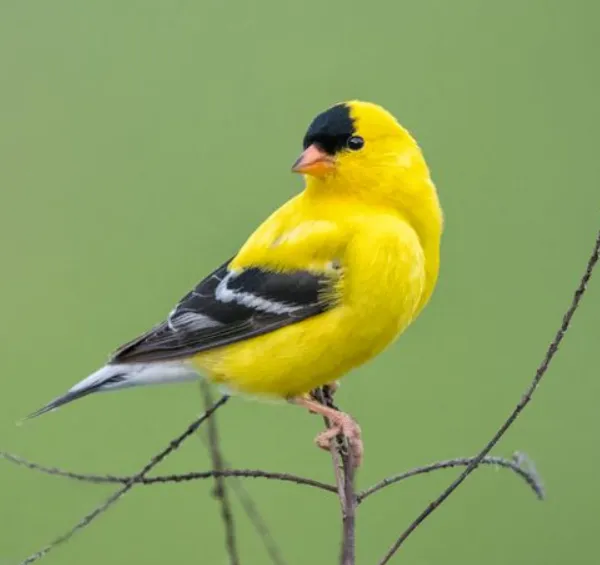
(Carduelis tristis) can easily be recognized by its bright yellow feathers, black wings with white markings, and pointed bill. In the summer, their diet consists mainly of seeds from thistle and dandelion plants. During the winter, they feed on seeds from a variety of trees and shrubs.
The American Goldfinch typically measures about 4.5 inches in length and has a wingspan of up to 8 inches.
In Idaho, American Goldfinches can be found in open woodlands, parks, and gardens. They are often seen in flocks, feeding and socializing together. During breeding season, they build their nests on trees or shrubs, using plant fibers and animal hair for construction.
American Goldfinches are known for their playful behavior, including hanging upside down to pick seeds from plants and flying up in the air before diving back down. They also have a unique song consisting of high-pitched, repetitive twitters.

Dark-eyed Junco
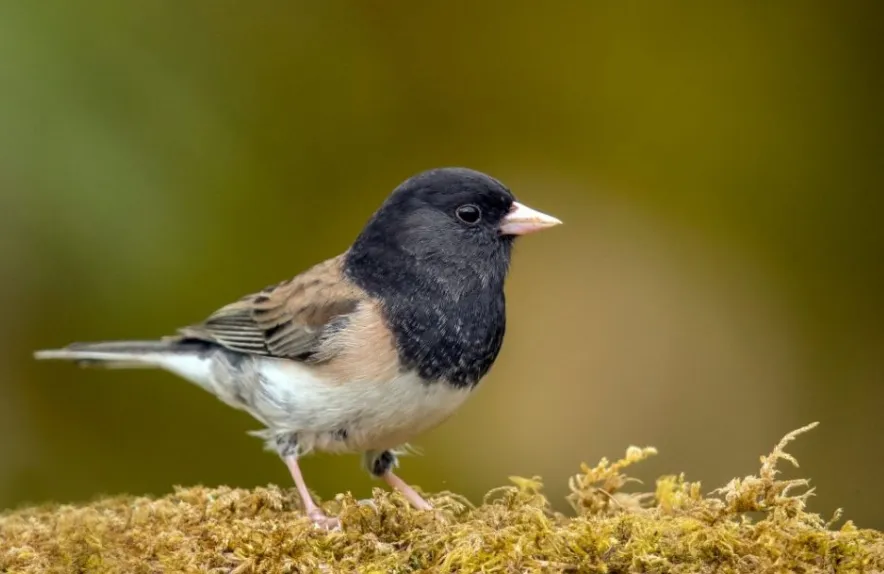
Dark-eyed Junco is a common bird in Idaho, typically found in coniferous forests and scrublands. They have a distinctive gray body with dark heads and white outer tail feathers. Their diet consists mainly of seeds and insects. These birds range in size from 6 to 7 inches in length.
In their natural habitat, Dark-eyed Juncos can often be seen foraging on the ground or on low shrubs. They are social birds and often flock with other small songbirds.
During mating season, male juncos may display their feathers and perform a “hop-flutter” courtship ritual to attract a mate.

Bay-breasted Warbler

is a small songbird measuring around 4.5-6 inches in length with a wingspan of 8-9 inches. It has a brownish-gray head, white throat, and breast with dark brown streaks, yellow underparts, and white wing bars.
This warbler feeds on insects and larvae found in coniferous trees. They can be found in coniferous or mixed forests during the breeding season and in flocks with other warblers during migration and winter.
These birds are known for their energetic behavior, constantly moving as they search for food. They also have a distinctive “chip” call. Bay-breasted Warblers breed in northern coniferous forests from Alaska to New England and can be found in Idaho during the breeding season. They also migrate through winter in southern parts of the United States and Mexico.

Cedar Waxwing
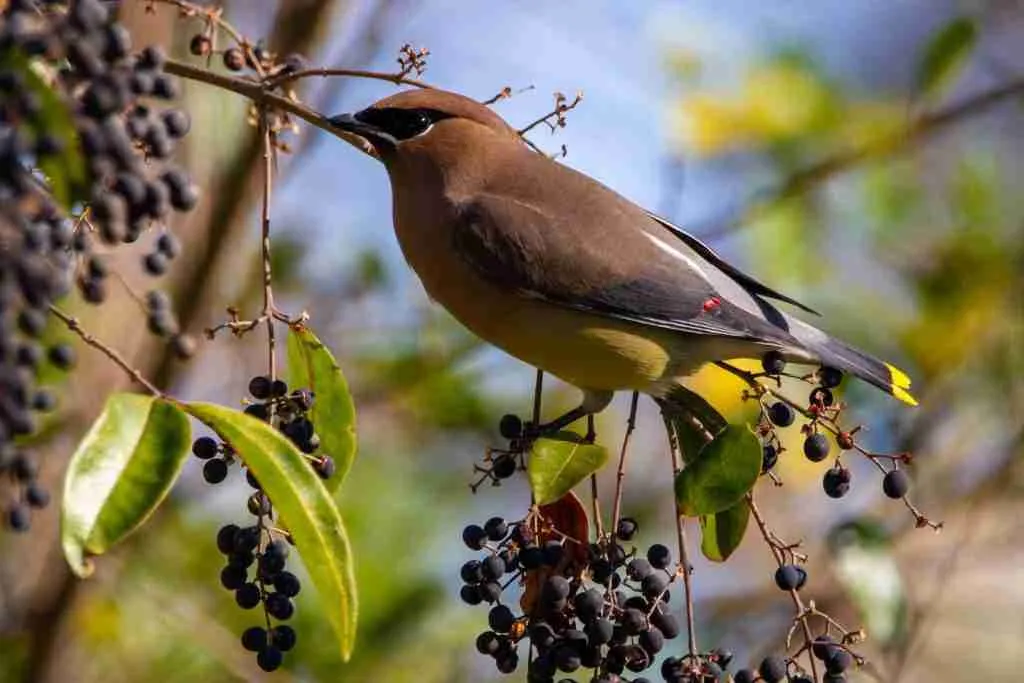
Cedar Waxwing birds can be identified by their sleek, glossy brown body and distinctive yellow and red tipped wings. They have a crest on top of their head and black mask-like markings around their eyes.
In Idaho, Cedar Waxwings primarily feed on berries and insects. They have also been known to eat flowers, nectar, and small fruits.
Cedar Waxwings have an average body length of 7-8 inches and a wingspan of 12-13 inches.
These birds can be found in deciduous or mixed forests, riparian areas, orchards, residential neighborhoods with trees and shrubs, and open grasslands.
In their habitat, Cedar Waxwings are sociable birds and can often be seen in flocks, especially during migration and winter months. They are known for their acrobatic flight abilities and melodious vocalizations. Additionally, Cedar Waxwings have been observed engaging in behaviors such as feather plucking and passing objects back and forth while in flight.

Black-billed Magpie

Black-billed Magpie is a large bird, measuring around 18 inches in length with black and white plumage, a long tail, and a distinctive black bill. They are omnivorous, feeding on small animals, insects, fruits, nuts, and carrion.
In Idaho, Black-billed Magpies can be found in open forests and woodlands, especially near water sources. They are known for their bold and curious behavior, often seen foraging or scavenging in groups. These social birds build large stick nests high in trees, and commonly mate for life.
While they have faced some persecution due to past beliefs that they harm game bird populations, Black-billed Magpies are now protected under the Migratory Bird Treaty Act. They have a stable population and can be often seen in suitable habitats throughout Idaho.

European Starlings
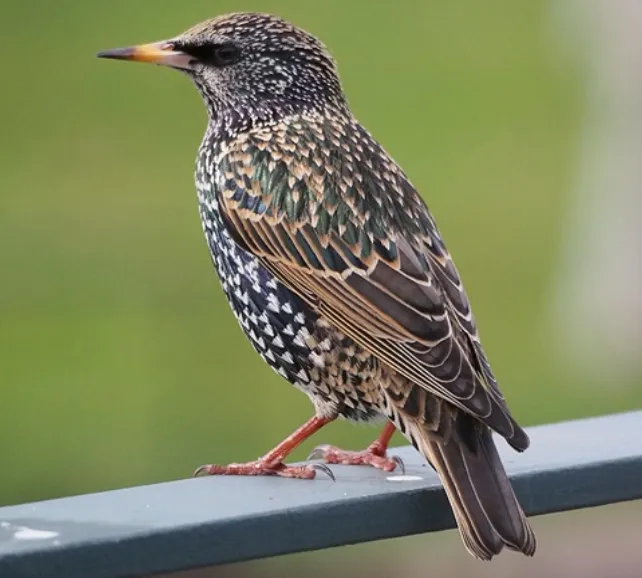
European Starlings, commonly found in Idaho, have distinctive iridescent black feathers with speckles of white. They primarily eat insects and fruits, but will also consume human foods such as bread and peanuts. These birds are small, typically measuring around 8 inches in length.
They can be found in a variety of habitats including open fields, woodlands, parks, and suburban areas. European Starlings are highly social, often forming large flocks and performing intricate aerial displays. They are also known for their impressive vocal abilities, with the ability to mimic sounds from their surroundings.
However, these birds can be considered pests due to their aggressive behavior towards native bird species and destruction of crops. Despite this, they remain a common sight in Idaho and across North America.

Black-capped Chickadees

Black-capped Chickadees are small birds with black cap and bibs, white cheeks, gray backs, and buffy underparts.
They can be found in a variety of wooded habitats, including coniferous and deciduous forests as well as urban parks and backyard bird feeders. These energetic birds eat mostly insects, seeds, and berries.
Chickadees are highly social and often travel in small flocks, constantly vocalizing their distinctive “chick-a-dee” call. In winter, they may join mixed-species foraging flocks with other small birds. Chickadees are also known for their remarkable ability to hide and store food for later retrieval, a behavior known as “hoarding.”

Brown-headed Cowbird
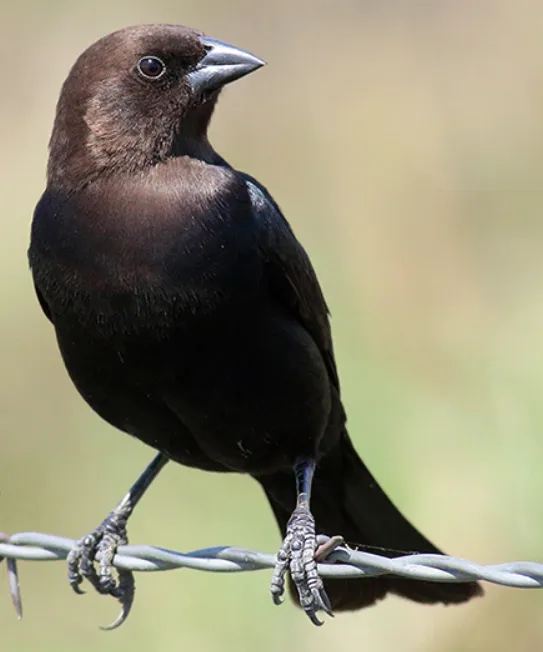
Brown-headed cowbirds are small blackbirds with distinct brown heads and glossy black bodies. They have slender bills, short tails, and long wings. Their diet consists mainly of insects and seeds gathered from the ground or gleaned from vegetation.
In Idaho, Brown-headed Cowbirds can often be found in open grasslands or agricultural fields. They are known for their parasitic breeding behavior, laying their eggs in the nests of other bird species to be raised by them. This can put a strain on the resources of the host bird and negatively impact its reproductive success.
During the winter months, Brown-headed Cowbirds may gather in large flocks with other blackbird species to forage for food. They are also known to follow herds of grazing animals, such as cattle or bison, to feed on insects disturbed by their movement.

Red-winged Blackbird
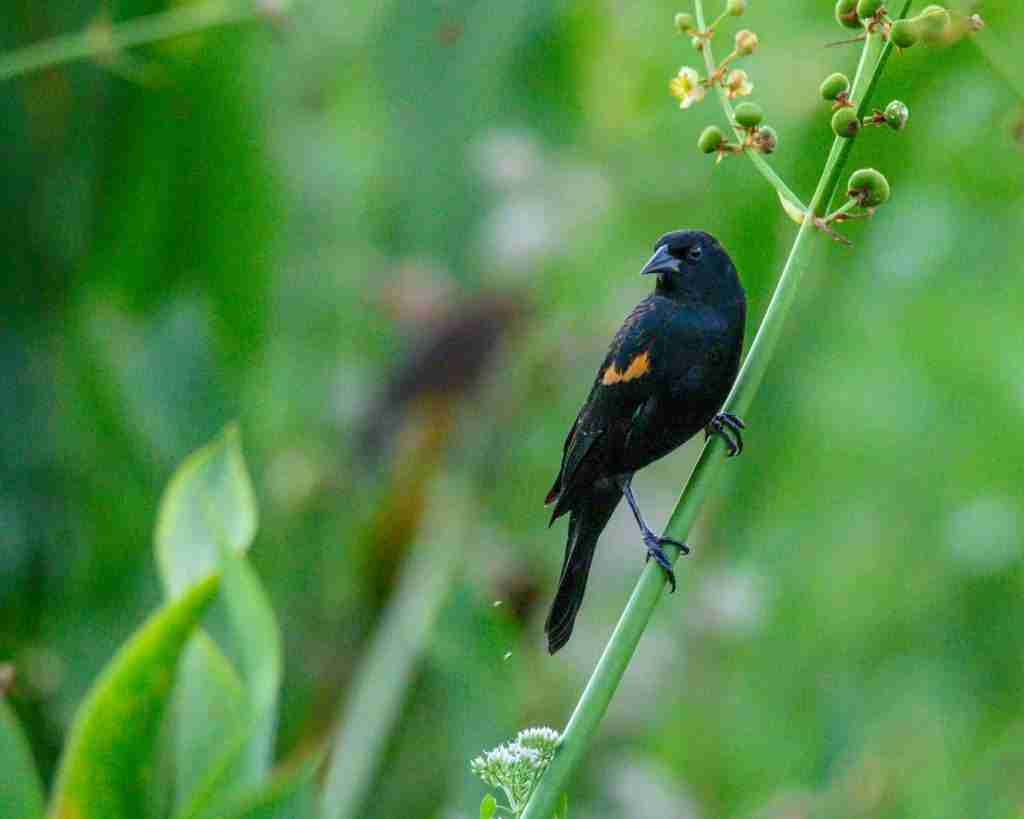
(Agelaius phoeniceus) can be identified by their black bodies and bright red and yellow shoulder patches. These birds mainly eat insects, seeds, and grains. They measure about 9-11 inches in length and have a wingspan of 13-17 inches.
They can be found in wetlands, marshes, grasslands, fields, and agricultural areas. Red-winged Blackbirds are known for their loud and repetitive calls and territorial behavior during breeding season. They often nest in wetlands and marshes, building their nests out of grasses and reeds high up in cattails or shrubs.
Outside of the breeding season, they form large flocks with other blackbird species. Red-winged Blackbirds are commonly seen perching on tall vegetation or flying overhead in large groups, called “blackbird flights.”
These birds can be found year-round in Idaho, with an increase in population during the summer months. They are also a common sight throughout much of North America.

Song Sparrow
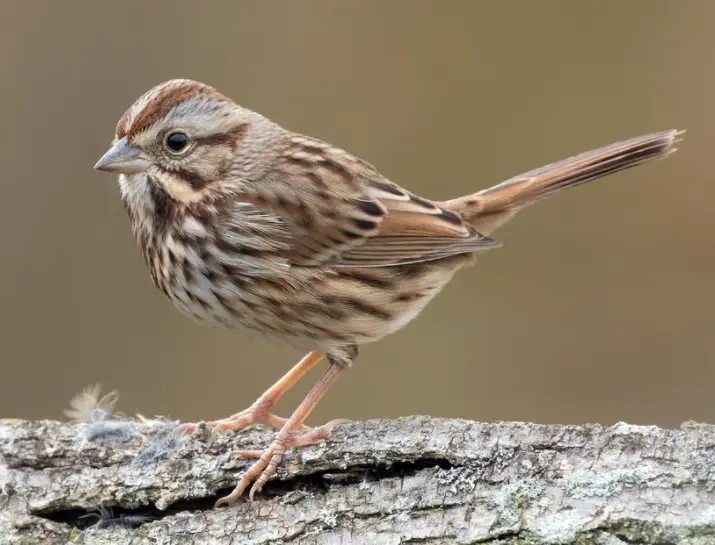
s can be identified by their brown streaked bodies, white throat, and distinct black V on their chest. They primarily eat insects and seeds. These birds range in size from 5 to 6 inches in length.
In Idaho, Song Sparrows can typically be found inhabiting brushy areas or grasslands near water sources. They are known for their songs, which consist of several different trills and chirps. These birds are also known for their aggressive behavior towards intruders in their territory.

Northern Flicker
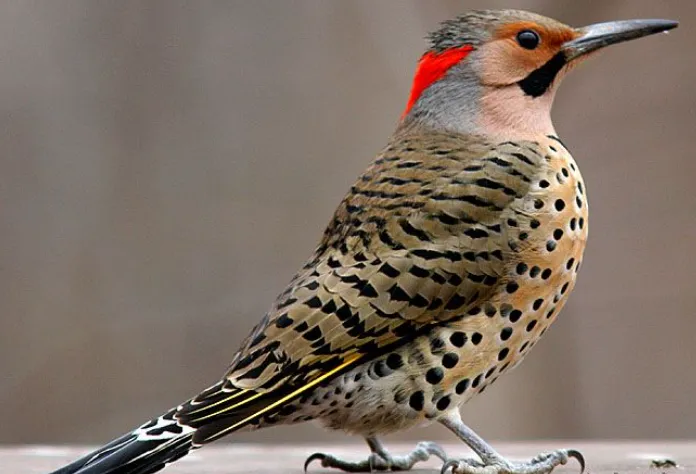
Northern Flicker woodpeckers can be identified by their red-shafted wings and black barred backs. They primarily eat insects, fruits, and nuts. These birds are typically around 12 inches in length with a wingspan of 18-20 inches. In Idaho, Northern Flickers can be found in open woodlands and parks.
They often forage on the ground and are known for their distinct “wick-up” call. They also drum on trees to communicate and find mates. In the winter, flickers may form small flocks with other woodpecker species.
They nest in tree cavities, sometimes excavated by the male. Northern Flickers are year-round residents of Idaho, but some southern flickers may migrate to the state in the winter.

Brewer’s Blackbird
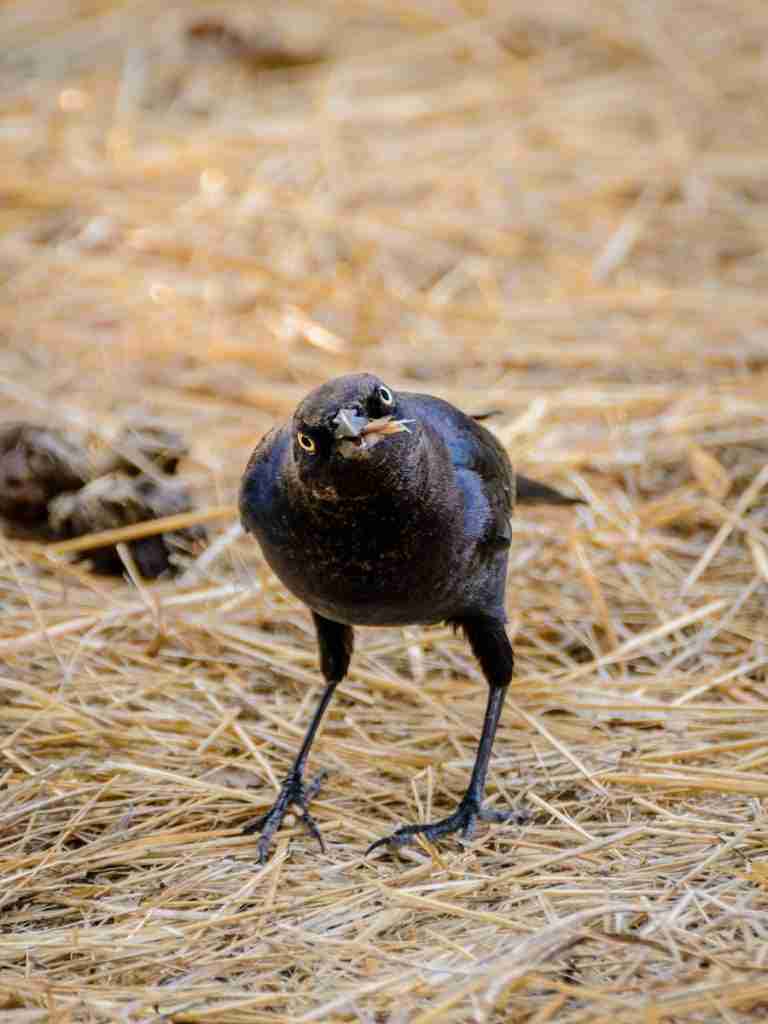
(Euphagus cyanocephalus) is a common bird in Idaho, often found in open fields and along the edges of forests. These black birds have iridescent purple heads and necks, yellow eyes, and pointed beaks. Their diet primarily consists of insects and seeds.
On average, they measure around 9-11 inches in length and have a wingspan of 13-17 inches.
In terms of behavior, Brewer’s Blackbirds are often seen in large flocks and can be aggressive towards other bird species when defending their territory.
They also engage in an interesting mating ritual where the male will collect materials to build a nest and present them to the female as a way of courtship.

Barn Swallows

Barn Swallows, identified by their dark blue plumage and long, pointed wings, can often be seen swooping through fields and near bodies of water in search of insects to eat. These small birds typically measure between 5-6 inches in length and have a wingspan of around 11 inches.
They prefer open areas with access to mud for building their cup-shaped nests and can often be found near farmland, lakes, and rivers. In Idaho, Barn Swallows can commonly be spotted during the spring and summer months as they migrate through the state on their way to their winter habitats in Central or South America.
In addition to their aerial insect-catching skills, Barn Swallows are known for their social behavior and ability to form large flocks. They have also been observed using tools, such as sticks and grass, to build their nests.

Western Tanager
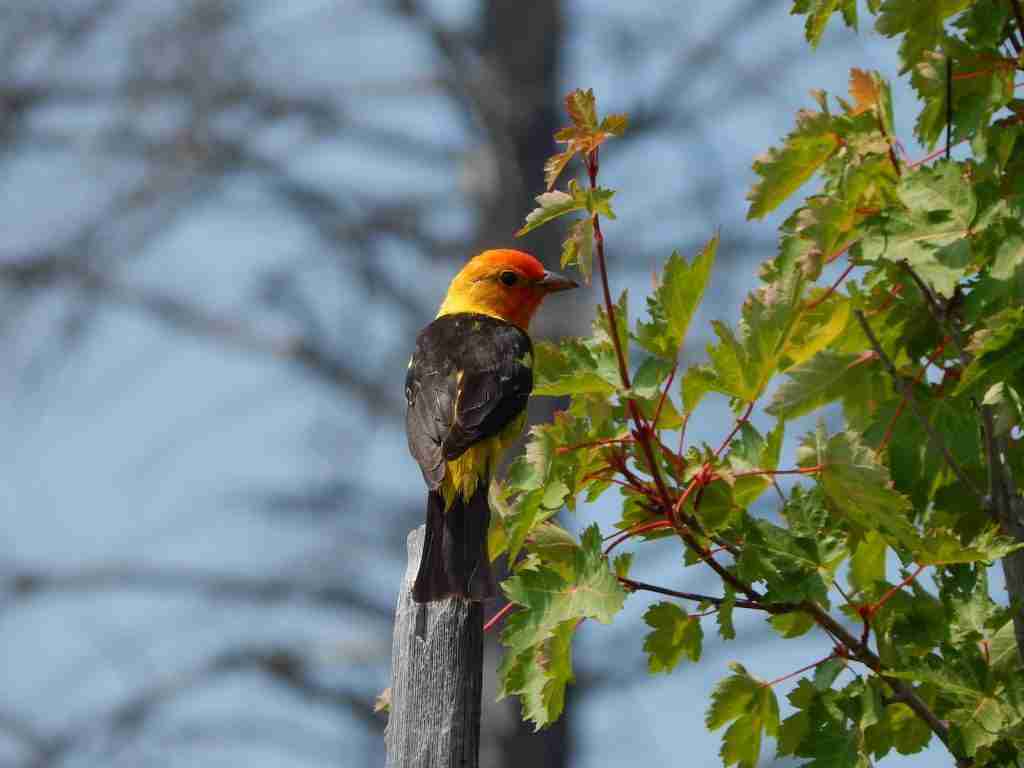
(Piranga ludoviciana) can be identified by their bright yellow bodies and distinctive red heads. They primarily eat insects and berries found in coniferous forests, where they often build their nests high up in the trees.
These birds are on the smaller side, measuring around 7 inches in length. In Idaho, they can commonly be found in the northern and central regions of the state during the summer months.
Western Tanagers are known for their energetic and acrobatic behavior, often seen flying quickly and darting between branches while foraging for food. They are also known to join mixed-species flocks during winter months.

Snow Bunting – Plectrophenax nivalis

In Idaho, Snow Buntings can be identified by their white and black feathers with a splash of rust on the wings. They primarily eat seeds and insects. These small birds measure about 6-7 inches in length with a wingspan of 9-10 inches.
Snow Buntings can typically be found in tundra and open, arctic regions during the breeding season. These winter birds can be found in more diverse habitats including grasslands, farm fields, and shorelines.
In terms of behavior, Snow Buntings are known for their harsh calls and strong flocking tendencies. They also have a unique courtship display where the male will fly high into the air and then dive down, spreading his tail and wings.

Lapland Longspur – Calcarius lapponicus

The Lapland Longspur can be identified by its black crown, white cheek patches, and brown streaked back. This bird primarily feeds on seeds and insects. It averages about 6 inches in length with a wingspan of 9-10 inches.
In Idaho, the Lapland Longspur can be found inhabiting open grasslands and tundra habitats. During the breeding season, it can also be found in agricultural fields.
This bird is known for its acrobatic flight behavior, often performing looping dives and zig-zagging patterns while foraging for food. It also engages in aerial displays during courtship rituals. Outside of the breeding season, the Lapland Longspur forms large flocks with other songbird species.

Harris’s Sparrow – Zonotrichia querula
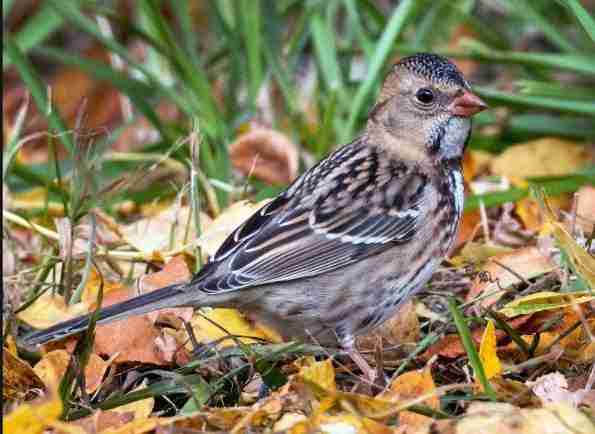
Harris’s Sparrow – is a medium-sized sparrow with a rusty-brown cap, white cheeks, and a distinct black stripe through the eye. It can be found in open grasslands or scrubby areas, often near trees or shrubs for cover. Its diet consists mainly of seeds and insects.
The Harris’s Sparrow typically travels in small flocks and can often be seen scratching at the ground to find food. During the breeding season, the male will perform aerial displays and sing complex songs to attract a mate.
The average size of Harris’s Sparrow ranges from 6-6.5 inches in length with a wingspan of 9-10 inches.

Downy Woodpecker – Picoides pubescens
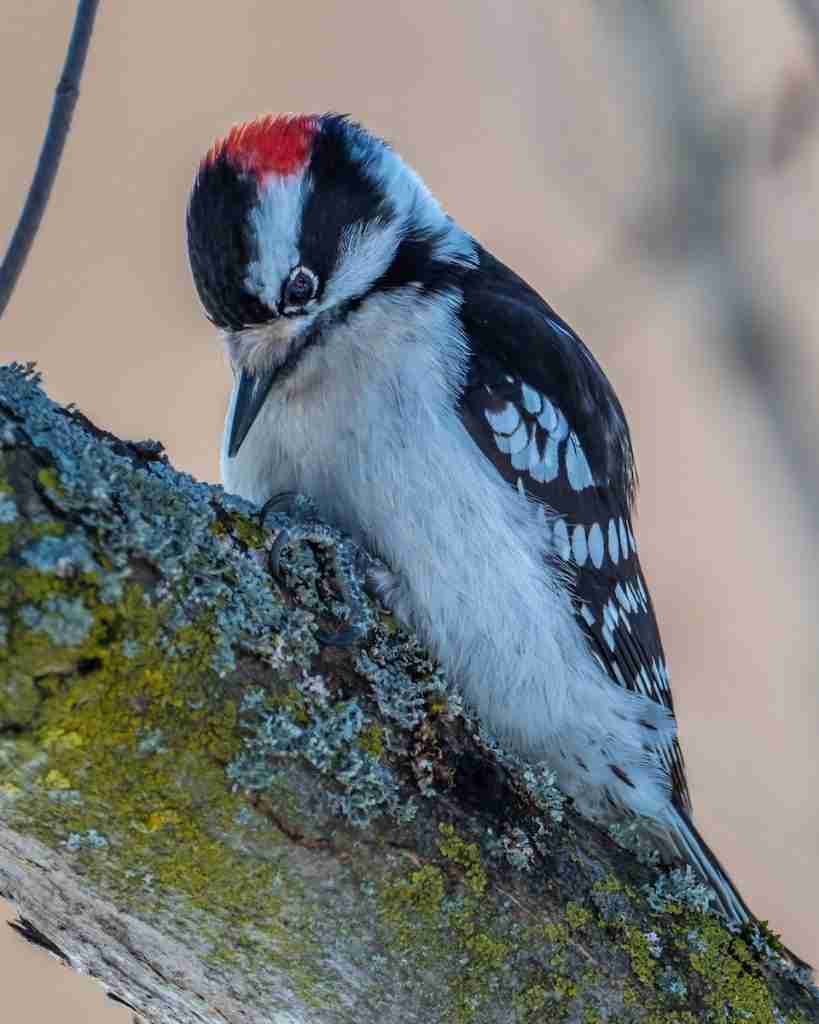
The Downy Woodpecker can be identified by its black and white barred wings and back, with a white belly and a conspicuous black stripe on its head. Its small size (6-7 inches in length) sets it apart from its larger relative, the Hairy Woodpecker.
In Idaho, the Downy Woodpecker primarily feeds on insects and larvae found in tree bark, as well as berries and nuts.
This bird can be found in a variety of wooded habitats, including deciduous forests, suburban areas, and even city parks. They often nest in dead trees or wooden fence posts.
Downy Woodpeckers are known for their drumming behavior, where they rapidly peck on trees or other surfaces to claim territory and attract mates. They also have the ability to hang upside down while foraging, making them quite acrobatic in their search for food.

Lazuli Bunting – Passerina amoena

The Lazuli Bunting is a small bird with bright blue feathers on its upper body and dull brown feathers on its underbody. Its distinguishing feature is a black head with white stripes above the eyes.
In terms of diet, the Lazuli Bunting primarily feeds on seeds and insects.
This bird typically measures around 5 inches in length and has a wingspan of 7-8 inches.
In Idaho, the Lazuli Bunting can be found in open grasslands and shrublands during the breeding season. In winter, they may also inhabit wooded areas or residential neighborhoods with bird feeders.
During breeding season, male Lazuli Buntings can often be seen performing acrobatic flight displays to attract a mate. They build cup-shaped nests in shrubs or low trees and typically lay 4-5 eggs per clutch. Both parents take part in feeding the young until they are ready to leave the nest.

Mountain Bluebird – Sialia currucoides
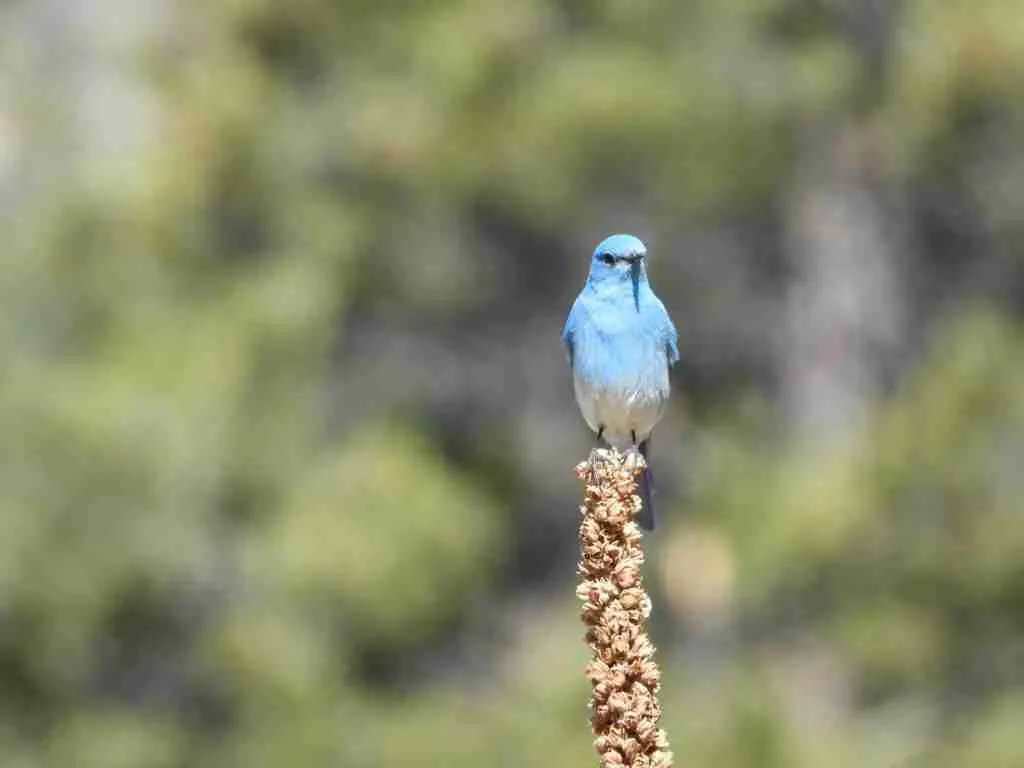
Mountain Bluebird – is a small bird, measuring about 6 to 7 inches in length and weighing just over an ounce. They have bright blue feathers on their upper parts and light grayish-brown feathers on their underparts. Their diet consists mainly of insects, but they will also eat berries and seeds.
In Idaho, Mountain Bluebirds can be found in open habitats such as grasslands, meadows, and agricultural fields. They prefer to build their nests in cavities or man-made nesting boxes.
Mountain Bluebirds are known for their graceful flight and they often perch on exposed branches or wires to hunt for food. They tend to move in small flocks during the winter months.
Mountain Bluebirds are a popular bird for birdwatchers, and their populations have remained stable. They are native to North America, with their range extending from southeastern Alaska down to Mexico.
In Idaho, they can typically be seen during the spring and summer months before migrating south for the winter. Protecting their habitat and providing nest boxes can help ensure the continued presence of these beautiful birds in Idaho.

Yellow-rumped Warbler – Setophaga coronata
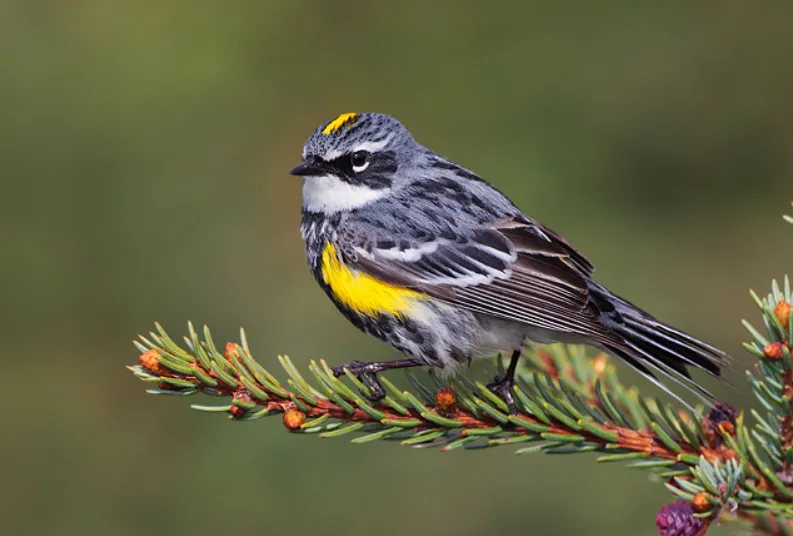
The Yellow-rumped Warbler can be easily identified by its bright yellow patch on its rump, as well as its white throat and gray upperparts. Its diet consists mainly of insects and berries. It typically measures about 5 to 6 inches in length.
In Idaho, the Yellow-rumped Warbler can be found in coniferous or mixed forests during the breeding season. It also frequents open woodlands, shrubby areas, and suburban yards during migration and in the winter.
This warbler is known for its vigorous and active foraging behavior, often seen acrobatically hanging from branches to catch insects. It also has a distinctive song that is a sharp “chimp” or “chek-a-chek.”

House Sparrow
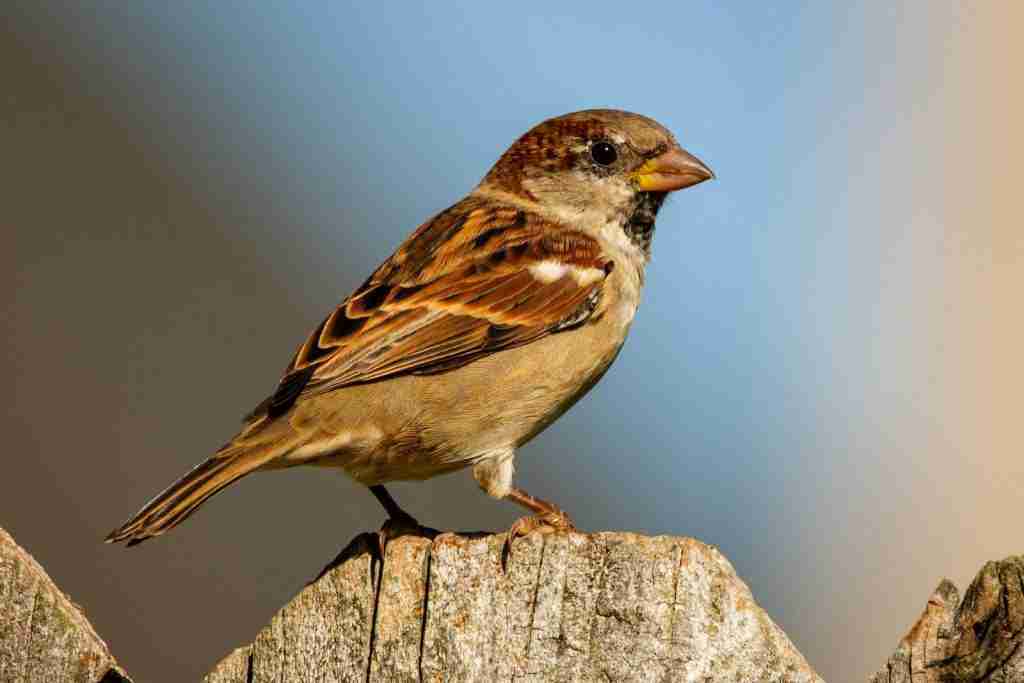
House Sparrows, commonly found in Idaho, can be identified by their stout build, brown back and wings, white undersides, and black throat and crown. They primarily eat grains and seeds, but will also feed on insects and fruits.
These small birds measure about 6 inches in length and can be found in a variety of habitats including urban areas, farms, and grasslands. In terms of behavior, House Sparrows tend to be social and can often be seen in large flocks.
They are also known for being aggressive towards other bird species while defending their nesting territory.

American Crow
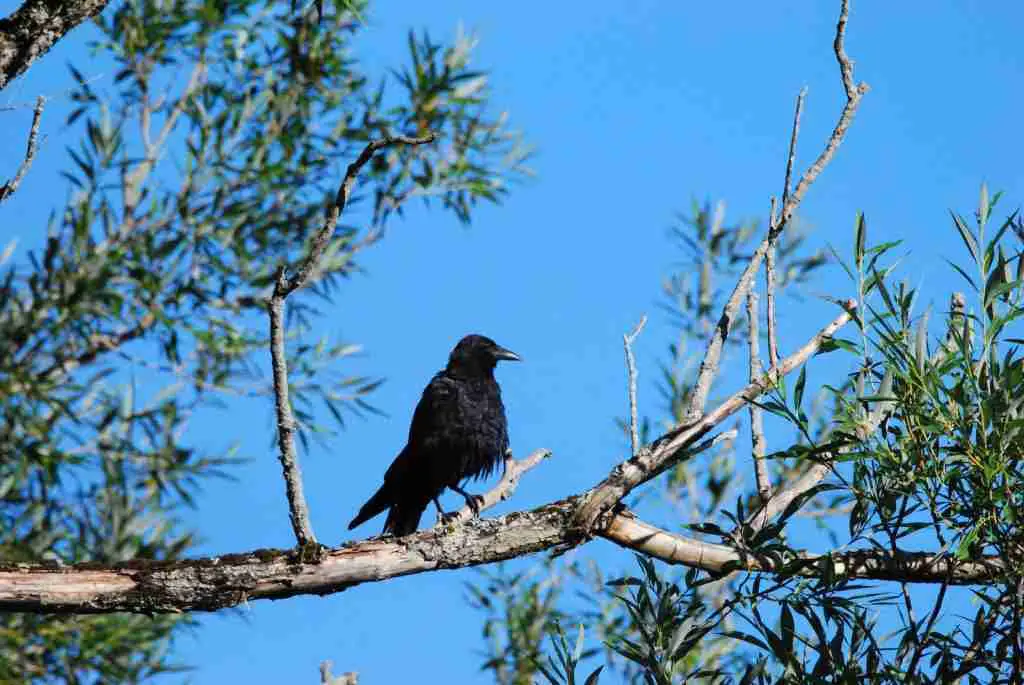
American Crow, also known as the common crow, can be identified by its black feathers and distinct cawing call. These birds are omnivores and will eat a variety of foods including grains, insects, small animals, and garbage. American Crows can reach roughly 17 inches in length with a wingspan of approximately 3 feet.
They can be found in a variety of habitats including open fields, forests, and suburban areas. In terms of behavior, American Crows often live in large groups and are known for their intelligence and problem-solving skills. They have also been observed using tools to obtain food.
While they don’t come to feeders as often as other birds, there are a few foods that attract them consistently.

What is the most common bird in Idaho?
The most common bird in Idaho is the American robin. Other common birds found in Idaho include the American goldfinch, house finch, and dark-eyed junco. These birds can be spotted in a variety of habitats including forests, meadows, and suburban areas.
In addition to these more common species, Idaho also has a diverse range of bird species including waterfowl, raptors, and songbirds. Bird watching is a popular activity in Idaho, with some of the best spots for viewing being Hells Gate State Park and Bruneau Dunes State Park.
How do I identify a bird in my backyard?
There are several steps you can take to identify a bird in your backyard. First, observe the bird’s physical characteristics such as size, shape, color, markings, and behavior.
Next, use a field guide or app to narrow down possible species based on these characteristics. If possible, listen for the bird’s call or song and use it to further narrow down potential species.
Finally, consult with local birding experts or organizations for confirmation of the bird’s identification. With practice and dedication, you will become a skilled backyard bird identifier!
What is a black and white bird in Idaho?
The most common black and white bird found in Idaho is the American White Pelican. These birds can often be seen near bodies of water, using their large bills to scoop up fish for food. They also have distinctive white and brown plumage, with a wingspan reaching up to 11 feet.
Other possible black and white bird sightings in Idaho include the Black-capped Chickadee, the Western Meadowlark, and the Ring-billed Gull.
Are Cardinals in Idaho?
The answer is yes, they can be found in the southern and eastern parts of the state. However, they are not as common as other bird species such as Western Meadowlarks or American Robins.
It’s best to visit natural areas like Snake River Birds of Prey National Conservation Area or Hells Canyon National Recreation Area to increase your chances of spotting a Cardinal. Additionally, providing bird feeders in your backyard can attract them to your space.
Other backyard birds in Idaho:
For more unique sightings, keep an eye out for the Mountain Chickadee, Pygmy Nuthatch, or even the rare Pinyon Jay. Bird watching is a popular activity in Idaho, with many areas offering great opportunities for viewing a diverse range of bird species.
Bird Feeders
Bird Feeders are a great way to attract birds to your yard or garden. Not only do they provide food for the birds, but they can also be a beautiful and enjoyable addition to your outdoor space. When choosing a bird feeder, it’s important to consider the type of birds you want to attract and the size of the feeder.
It’s also important to regularly clean and refill the feeder to ensure the birds have a reliable source of food. Hang your bird feeder in a spot that is easily accessible for the birds and away from potential predators. With a little patience and proper care, you will soon be able to enjoy watching the delightful presence of birds in your own backyard.

An avid ornithologist, zoologist and biologist with an unwavering passion for birds and wild animals.
Dr. Wilson’s journey in ornithology began in childhood and led him to obtain a Ph.D. in Ornithology from the prestigious Avian Research Institute. He has worked closely with renowned experts in the field and conducted extensive research and field studies globally.

